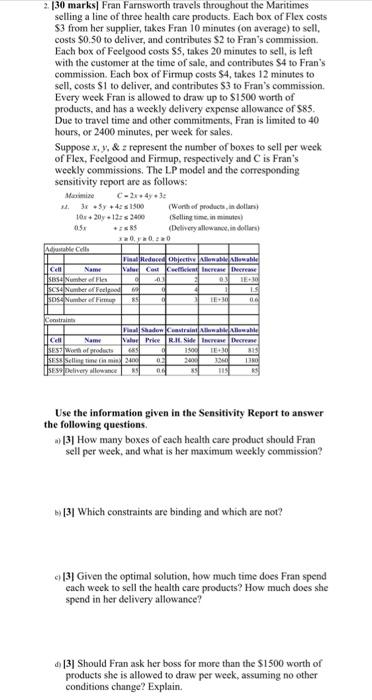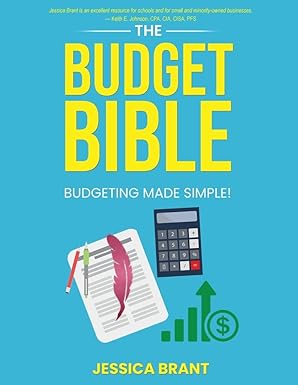2. 130 marks Fran Farnsworth travels throughout the Maritimes selling a line of three health care products. Each box of Flex costs S3 from her supplier, takes Fran 10 minutes (on average) to sell, costs $0.50 to deliver, and contributes S2 to Fran's commission Each box of Feelgood costs S5, takes 20 minutes to sell, is left with the customer at the time of sale, and contributes $4 to Fran's commission. Each box of Firmup costs $4, takes 12 minutes to sell, costs $1 to deliver, and contributes S3 to Fran's commission Every week Fran is allowed to draw up to $1500 worth of products, and has a weekly delivery expense allowance of $85. Due to travel time and other commitments, Fran is limited to 40 hours, or 2400 minutes, per week for sales. Supposex. y. & z represent the number of boxes to sell per week of Flex, Feelgood and Firmup, respectively and C is Fran's weekly commissions. The LP model and the corresponding sensitivity report are as follows: Marimize s. 3x5y + 1500 (Worth of products, in dollars 10x + 20y = 1212400 **R$ (Delivery allowance, in dolls Atable dilo Redeed Objectionable Cost effect there 0 Cell Name ses where Fier scs Number of dood! Sosure of RS Kontrain |Padamiraimismathe Cell Name V Pre R.L. Side Decrease ISES We of prodests TE 315 SESS Selling time in min: 2400 SES9liveryone RS BE 115 10 Use the information given in the Sensitivity Report to answer the following questions (3| How many boxes of each health care product should Fran sell per week, and what is her maximum weekly commission? (3) Which constraints are binding and which are not? [3] Given the optimal solution, how much time does Fran spend each week to sell the health care products? How much does she spend in her delivery allowance? [3] Should Fran ask her boss for more than the $1500 worth of products she is allowed to draw per week, assuming no other conditions change? Explain. 2. 130 marks Fran Farnsworth travels throughout the Maritimes selling a line of three health care products. Each box of Flex costs S3 from her supplier, takes Fran 10 minutes (on average) to sell, costs $0.50 to deliver, and contributes S2 to Fran's commission Each box of Feelgood costs S5, takes 20 minutes to sell, is left with the customer at the time of sale, and contributes $4 to Fran's commission. Each box of Firmup costs $4, takes 12 minutes to sell, costs $1 to deliver, and contributes S3 to Fran's commission Every week Fran is allowed to draw up to $1500 worth of products, and has a weekly delivery expense allowance of $85. Due to travel time and other commitments, Fran is limited to 40 hours, or 2400 minutes, per week for sales. Supposex. y. & z represent the number of boxes to sell per week of Flex, Feelgood and Firmup, respectively and C is Fran's weekly commissions. The LP model and the corresponding sensitivity report are as follows: Marimize s. 3x5y + 1500 (Worth of products, in dollars 10x + 20y = 1212400 **R$ (Delivery allowance, in dolls Atable dilo Redeed Objectionable Cost effect there 0 Cell Name ses where Fier scs Number of dood! Sosure of RS Kontrain |Padamiraimismathe Cell Name V Pre R.L. Side Decrease ISES We of prodests TE 315 SESS Selling time in min: 2400 SES9liveryone RS BE 115 10 Use the information given in the Sensitivity Report to answer the following questions (3| How many boxes of each health care product should Fran sell per week, and what is her maximum weekly commission? (3) Which constraints are binding and which are not? [3] Given the optimal solution, how much time does Fran spend each week to sell the health care products? How much does she spend in her delivery allowance? [3] Should Fran ask her boss for more than the $1500 worth of products she is allowed to draw per week, assuming no other conditions change? Explain







